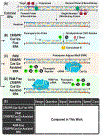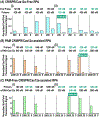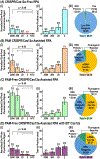Elucidating the Role of CRISPR/Cas in Single-Step Isothermal Nucleic Acid Amplification Testing Assays
- PMID: 36745596
- PMCID: PMC10884613
- DOI: 10.1021/acs.analchem.2c05632
Elucidating the Role of CRISPR/Cas in Single-Step Isothermal Nucleic Acid Amplification Testing Assays
Abstract
Developing assays that combine CRISPR/Cas and isothermal nucleic acid amplification has become a burgeoning research area due to the novelty and simplicity of CRISPR/Cas and the potential for point-of-care uses. Most current research explores various two-step assays by appending different CRISPR/Cas effectors to the end of different isothermal nucleic acid amplification methods. However, efforts in integrating both components into more ideal single-step assays are scarce, and poor-performing single-step assays have been reported. Moreover, lack of investigations into CRISPR/Cas in single-step assays results in incomplete understanding. To fill this knowledge gap, we conducted a systematic investigation by developing and comparing assays that share the identical recombinase polymerase amplification (RPA) but differ in CRISPR/Cas12a. We found that the addition of CRISPR/Cas12a indeed unlocks signal amplification but, at the same time, impedes RPA and that CRISPR/Cas12a concentration is a key parameter for attenuating RPA impediment and ensuring assay performance. Accordingly, we found that our protospacer adjacent motif (PAM)-free CRISPR/Cas12a-assisted RPA assay, which only moderately impeded RPA at its optimal CRISPR/Cas12a concentration, outperformed its counterparts in assay design, signal, sensitivity, and speed. We also discovered that a new commercial Cas12a effector could also drive our PAM-free CRISPR/Cas12a-assisted RPA assay and reduce its cost, though simultaneously lowering its signal. Our study and the new insights can be broadly applied to steer and facilitate further advances in CRISPR/Cas-based assays.
Conflict of interest statement
Notes
The authors declare no competing financial interest.
Figures




Similar articles
-
One-Pot Molecular Diagnosis of Acute Hepatopancreatic Necrosis Disease by Recombinase Polymerase Amplification and CRISPR/Cas12a with Specially Designed crRNA.J Agric Food Chem. 2023 Apr 26;71(16):6490-6498. doi: 10.1021/acs.jafc.2c08689. Epub 2023 Apr 4. J Agric Food Chem. 2023. PMID: 37014765
-
A PAM-Free One-Step Asymmetric RPA and CRISPR/Cas12b Combined Assay (OAR-CRISPR) for Rapid and Ultrasensitive DNA Detection.Anal Chem. 2024 Apr 9;96(14):5471-5477. doi: 10.1021/acs.analchem.3c05545. Epub 2024 Mar 29. Anal Chem. 2024. PMID: 38551977
-
A photocontrolled one-pot isothermal amplification and CRISPR-Cas12a assay for rapid detection of SARS-CoV-2 Omicron variants.Microbiol Spectr. 2024 Mar 5;12(3):e0364523. doi: 10.1128/spectrum.03645-23. Epub 2024 Feb 6. Microbiol Spectr. 2024. PMID: 38319081 Free PMC article.
-
Digital Recombinase Polymerase Amplification, Digital Loop-Mediated Isothermal Amplification, and Digital CRISPR-Cas Assisted Assay: Current Status, Challenges, and Perspectives.Small. 2023 Dec;19(49):e2303398. doi: 10.1002/smll.202303398. Epub 2023 Aug 23. Small. 2023. PMID: 37612816 Review.
-
Integrating CRISPR/Cas within isothermal amplification for point-of-Care Assay of nucleic acid.Talanta. 2022 Jun 1;243:123388. doi: 10.1016/j.talanta.2022.123388. Epub 2022 Mar 12. Talanta. 2022. PMID: 35303554 Review.
Cited by
-
Tunable control of Cas12 activity promotes universal and fast one-pot nucleic acid detection.Nat Commun. 2025 Jan 30;16(1):1166. doi: 10.1038/s41467-025-56516-3. Nat Commun. 2025. PMID: 39885211 Free PMC article.
-
Portable microfluidic devices for monitoring antibiotic resistance genes in wastewater.Mikrochim Acta. 2024 Dec 21;192(1):19. doi: 10.1007/s00604-024-06898-w. Mikrochim Acta. 2024. PMID: 39708170 Review.
-
PAM-free hairpin target binding activates trans-cleavage activity of Cas12a.Nucleic Acids Res. 2025 Jun 20;53(12):gkaf596. doi: 10.1093/nar/gkaf596. Nucleic Acids Res. 2025. PMID: 40557869 Free PMC article.
-
Application of a clamshell isothermal nucleic acid amplification analyzer in the detection of lower respiratory tract bacteria.Pract Lab Med. 2024 Apr 16;40:e00394. doi: 10.1016/j.plabm.2024.e00394. eCollection 2024 May. Pract Lab Med. 2024. PMID: 38680549 Free PMC article.
References
-
- Kaminski MM; Abudayyeh OO; Gootenberg JS; Zhang F; Collins JJ Nat. Biomed. Eng 2021, 5, 643–656. - PubMed
Publication types
MeSH terms
Substances
Grants and funding
LinkOut - more resources
Full Text Sources
Miscellaneous

